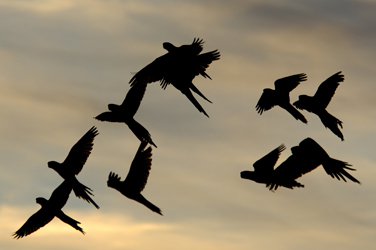Forest regeneration may reduce the current loss of species due to tropical deforestation, but little is known about the extent and inter-specific variability of this effect. Authors compared the probability with which nine parrot species use old-growth and secondary forests in a 400 km2 Amazonian landscape, while considering two types of habitat use: perching and flyover use. Perching use, when individuals stop at a sampling site; flyover merely implies that parrots fly through, above the canopy at a site. 155 sampling sites were established and sampled repeatedly using autonomous audio recorders. All but one species fly over both habitats with the same probability, while seven out of nine show a higher probability of perching in old growth than in secondary forest. Interspecific variation in response to habitat change was not explained by variation in body mass or relative brain size. After three decades of forest regeneration in the study area, there are still measurable differences in habitat use, with a broad tendency for parrots to favor old growth over secondary forest. informacion[at]ebd.csic.es Figueira et al (2015) Autonomous sound monitoring shows higher use of Amazon old growth than secondary forest by parrots. Biol Conserv 184: 27-35 doi:10.1016/j.biocon.2014.12.020
http://www.sciencedirect.com/science/article/pii/S0006320714004996


 Open Call for Research Projects in ICTS-Doñana!
Open Call for Research Projects in ICTS-Doñana!



